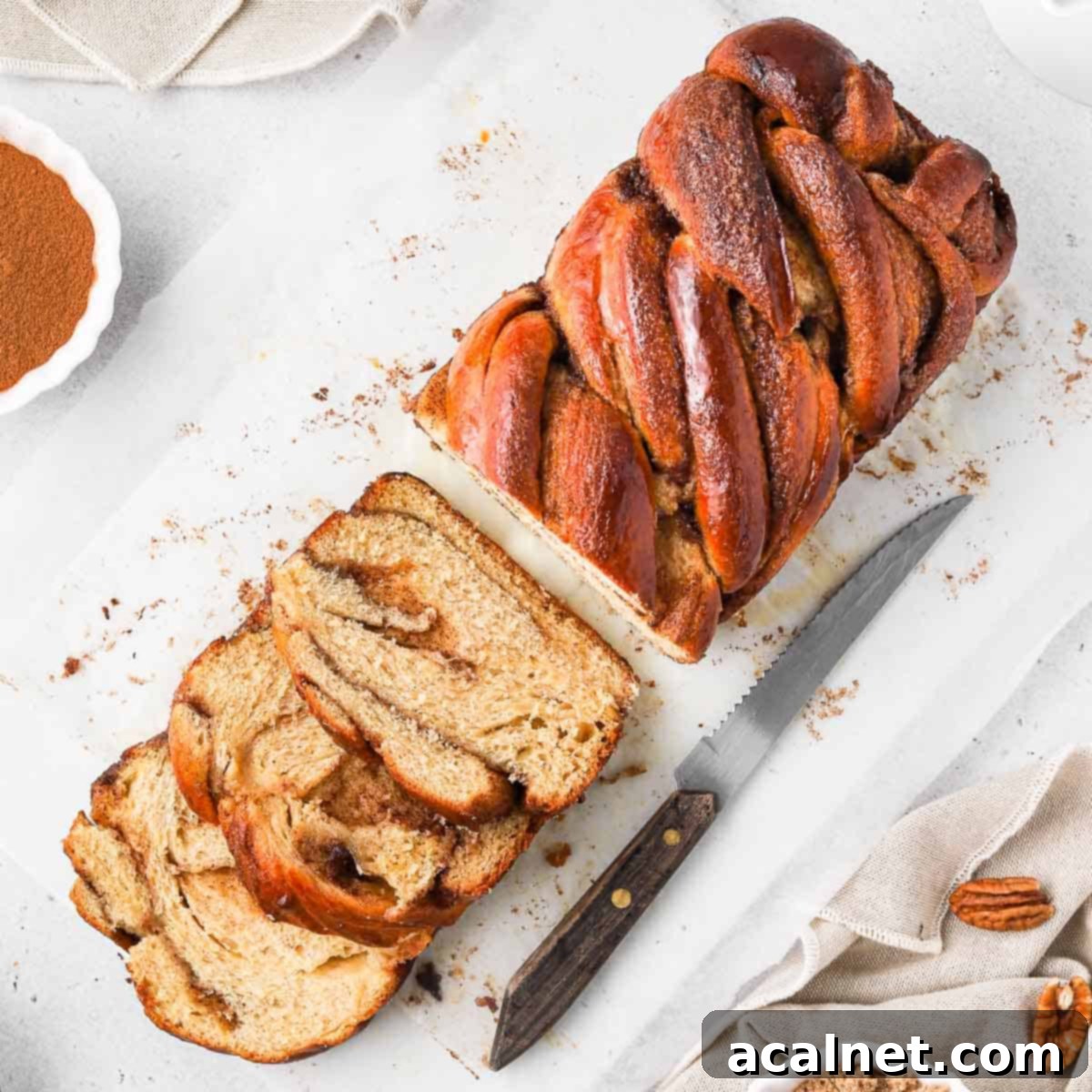Indulge in Homemade Bliss: The Ultimate Cinnamon Babka Recipe
Prepare to be captivated by this extraordinary Cinnamon Babka – an incredibly rich, sweet, and buttery twisted bread, generously swirled with aromatic cinnamon. This isn’t just a dessert; it’s an experience. Each slice of this cinnamon twist bread is a symphony of soft, fluffy texture and utterly irresistible flavor. Whether you’re toasting a piece for a luxurious breakfast, serving it as an elegant dessert, or savoring it with your afternoon tea, this babka promises pure delight. Its beautiful braided appearance and intoxicating aroma will fill your home and your heart.
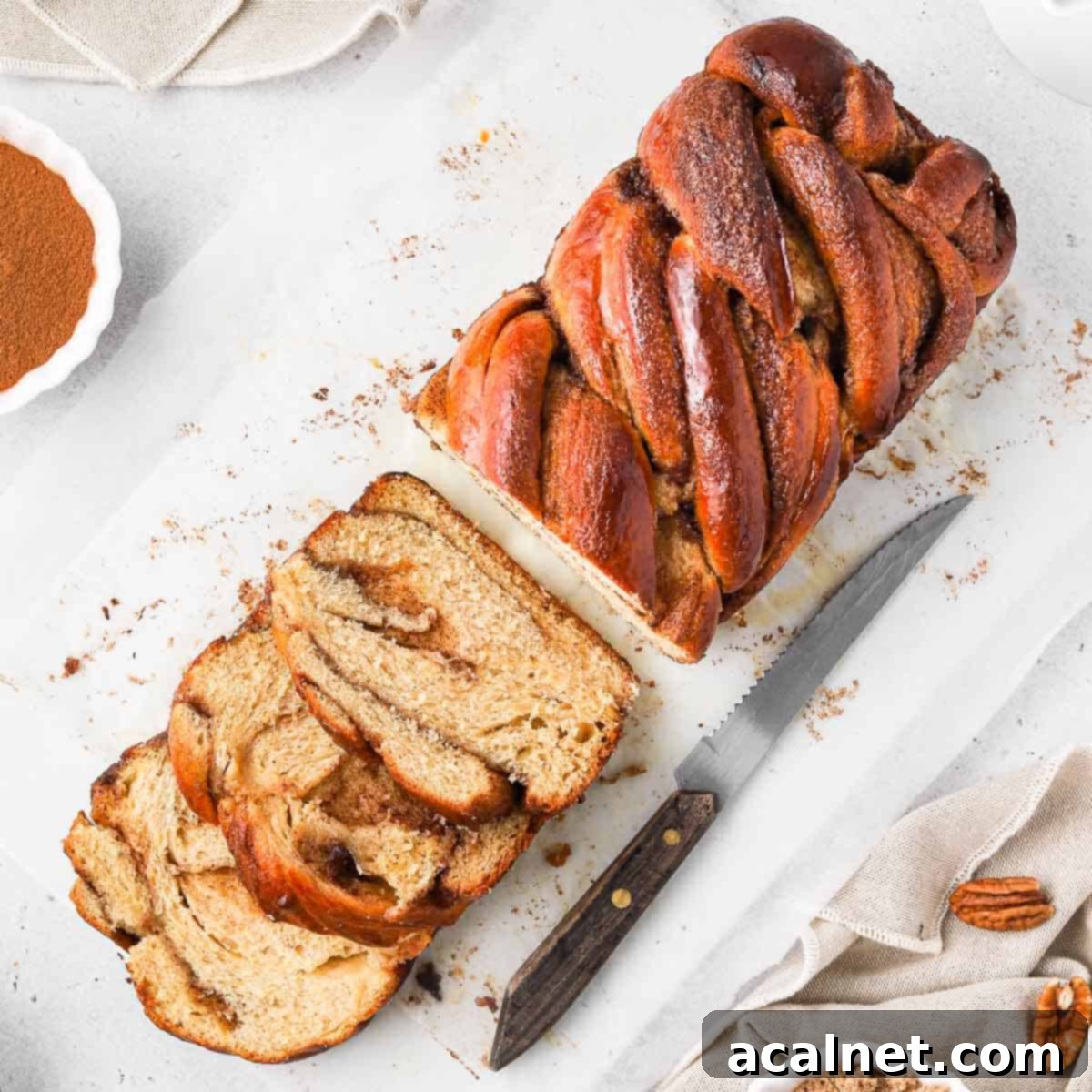
[feast_advanced_jump_to]
Why This Cinnamon Babka Recipe is a Must-Try
When we say this Cinnamon Babka loaf is utterly irresistible, we mean it with every fiber of our being. This isn’t just another sweet bread; it’s a culinary journey that will have you reaching for slice after slice. Its rich, buttery flavor and soft, tender crumb are simply divine. Imagine the comforting aroma of warm cinnamon filling your kitchen, promising a delightful treat that’s both indulgent and heartwarming. This babka offers a sophisticated twist on classic cinnamon roll bread, elevating a familiar favorite into something truly special.
The secret lies in the brioche-style yeasted dough, which is a tender, buttery marvel in itself. But it’s the lavish swirls of gooey cinnamon and brown sugar filling that truly set this babka apart. Each bite delivers a perfect balance of spice, sweetness, and rich, tender bread. It’s a perfect treat for any occasion, capable of transforming an ordinary moment into a memorable one. Just like a batch of freshly baked Cinnamon Scrolls, the scent alone is enough to entice everyone in your home.
Understanding Babka: History and Definition
A babka is a traditional Eastern European Jewish enriched yeasted bread, instantly recognizable by its distinctive twisted or braided shape. Historically, babkas were filled with simple, comforting ingredients such as fruit jam, cinnamon, or dried fruits. Over time, particularly as Jewish communities immigrated to America, new variations emerged, most notably the beloved chocolate babka. The name “babka” itself is thought to come from the Polish word “babcia,” meaning grandmother, or “baba,” meaning old woman or grandmother, reflecting its traditional, comforting, and home-baked nature.
So, what exactly is the difference between a Babka, a Challah, and a Brioche? At its core, a babka dough is very similar to a brioche dough: both are enriched sweet breads made with yeast, eggs, and butter, giving them their characteristic richness and tender texture. However, a traditional Challah, while also an enriched yeasted dough, is typically made dairy-free, often using oil instead of butter, especially for Shabbat (Sabbath) observance. This distinction highlights the unique culinary traditions and dietary laws that influenced the evolution of these delicious breads.
It is widely believed that babkas were originally invented by Polish Jews as an ingenious way to utilize leftover challah dough prepared for Shabbat. This historical connection suggests that the earliest babkas would have been dairy-free, making them suitable for consumption with meat meals, aligning with kosher dietary laws. Over centuries, this practice evolved, leading to the buttery, egg-rich babka we cherish today, often enjoyed as a standalone treat or dessert.
Essential Ingredients for Your Cinnamon Babka
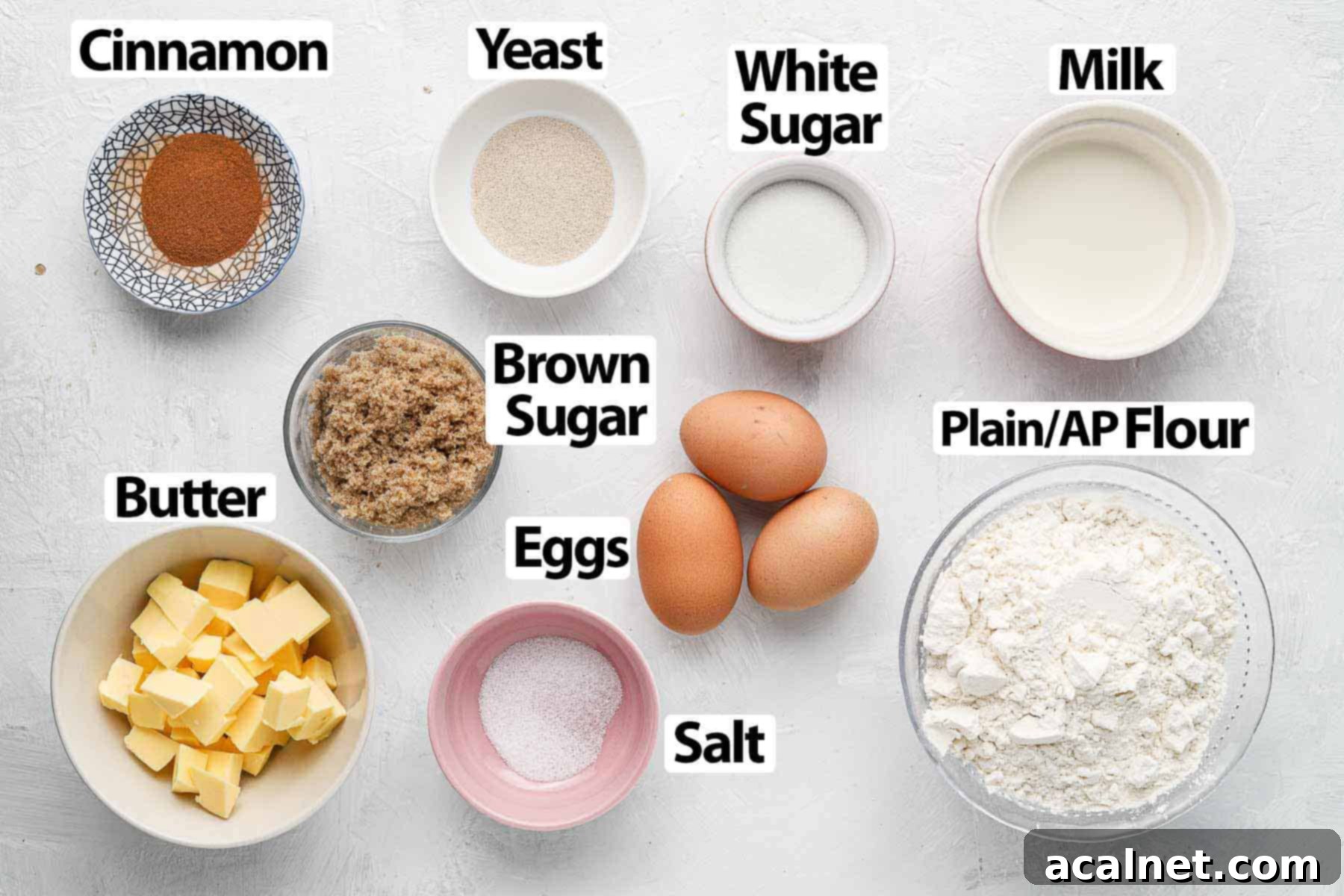
Crafting this delightful cinnamon babka involves three distinct, yet harmonious, components: the rich, sweet dough (quite similar to a classic French Brioche), the luscious cinnamon filling, and the optional but highly recommended sugar syrup brushed over the babka after baking for a beautiful shine and extra sweetness.
Here’s a detailed look at what goes into making this incredible cinnamon babka (refer to the recipe card below for exact quantities):
For the Enriched Babka Dough:
- Milk: We recommend using Full Cream / Whole Milk for its higher fat content, which contributes significantly to a richer flavor and a more tender texture. While you can substitute with water, be aware that this will result in a less flavorful and slightly less soft dough. Ensure the milk is lukewarm to properly activate the yeast without killing it.
- Yeast: This recipe calls for Instant (dried) Yeast, known for its convenience as it doesn’t require prior activation. However, if you prefer or only have Active Dry Yeast, simply “bloom” or re-hydrate it in a portion of the lukewarm milk with a pinch of sugar for about 5-10 minutes until it becomes frothy before adding other ingredients. This confirms the yeast is active.
- Sugar: Caster Sugar, or fine white granulated sugar, is ideal for its quick dissolving properties and even sweetness. For a deeper, more caramel-like flavor profile, you can experiment with replacing a portion of the caster sugar with brown sugar.
- Plain / All-Purpose Flour: This is our preferred choice for achieving a light, fluffy, and tender crumb in the babka. While bread flour can be used, it contains a higher protein content which tends to develop more gluten, potentially resulting in a slightly chewier, denser texture than desired for a traditional babka.
- Salt & Cinnamon: A touch of fine table salt is crucial for enhancing all the other flavors in the dough and controlling yeast activity. The addition of ground cinnamon directly into the dough is optional but highly recommended; it provides a wonderful underlying cinnamon aroma and flavor that complements the filling perfectly.
- Eggs: Medium-sized eggs are used to enrich the dough, contributing to its tender texture, golden color, and overall structure. It is absolutely vital for the eggs to be at room temperature; cold eggs can stiffen the butter and hinder proper gluten development, affecting the dough’s rise and texture. An additional egg is used for the egg wash, providing a beautiful golden-brown crust before baking.
- Unsalted Butter: The cornerstone of an enriched dough, unsalted butter adds incredible richness and moisture. It must be very soft and at room temperature for seamless incorporation into the dough, ensuring a smooth, pliable texture.
For the Irresistible Cinnamon Filling:
This simple yet potent filling is a classic blend of soft unsalted Butter, rich Brown Sugar, and fragrant Ground Cinnamon. The brown sugar adds moisture and a deeper molasses flavor that caramelizes beautifully during baking. For those who love to experiment, feel free to customize this filling: consider adding other warm spices like cardamom, a hint of nutmeg or ginger, a handful of mini chocolate chips or chunks, or even finely chopped nuts such as walnuts or pecans for added texture and flavor dimension.
For the Luminous Sugar Syrup (Optional, but Recommended):
A simple sugar syrup made with just Water and Caster Sugar (fine white granulated sugar) is brushed over the hot babka post-baking. This step isn’t just for extra sweetness; it adds a beautiful glossy sheen, keeps the babka moist, and extends its freshness. For an extra layer of flavor, you can infuse the syrup with a splash of vanilla extract or paste, or even a citrus zest.
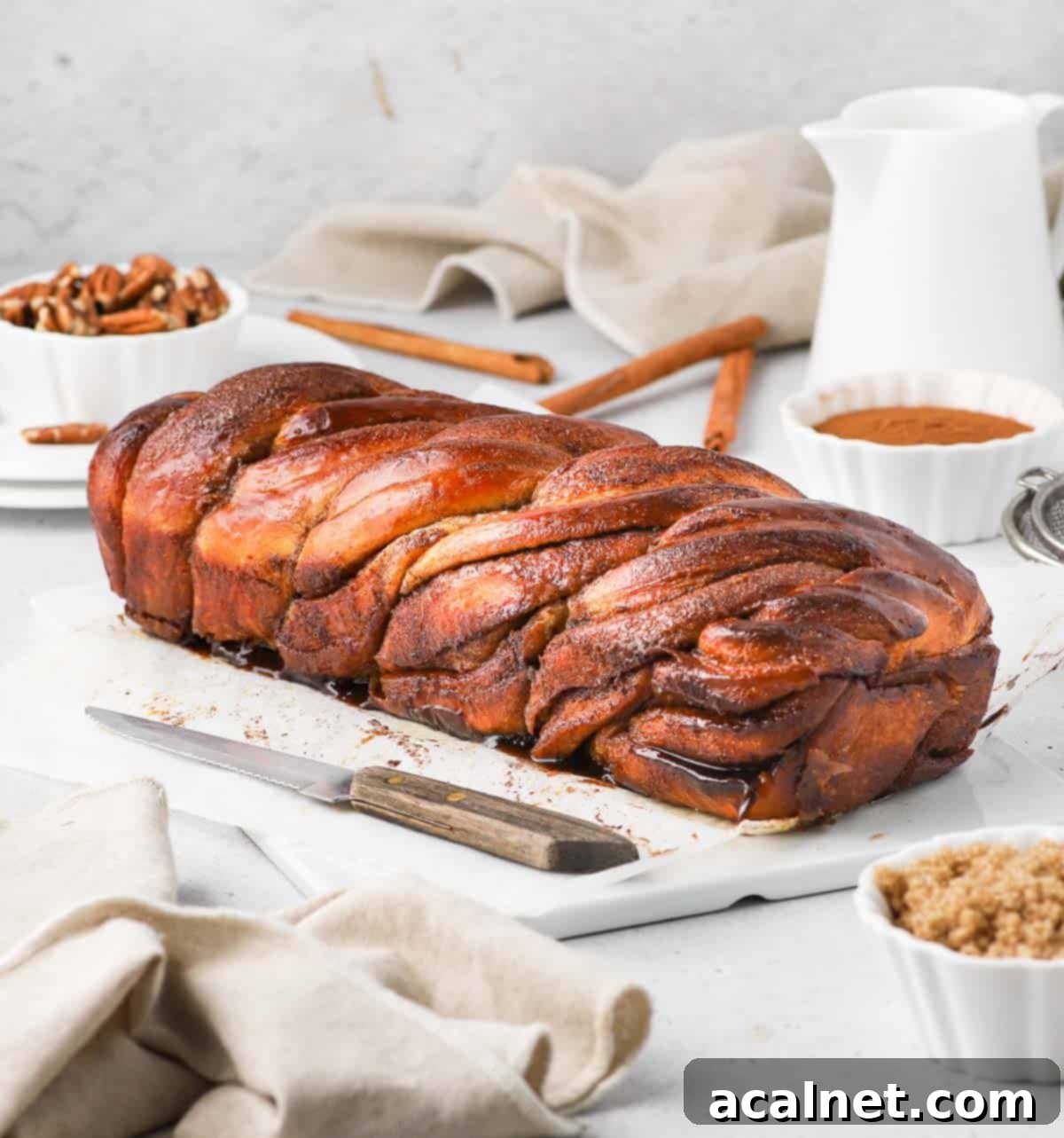
How to Make Cinnamon Babka: A Detailed Step-by-Step Guide
Creating this beautiful Cinnamon Babka is a rewarding baking project that follows a logical flow. The process begins with preparing the rich, brioche-style dough and allowing it to rise. Next, you’ll roll out the risen dough, generously fill it with the fragrant cinnamon mixture, and then artfully twist it to achieve its signature braided shape. Finally, it’s baked to golden perfection. For an exquisite finish, consider brushing the warm babka with a sweet sugar syrup straight out of the oven, adding a delightful shine and extra moisture.
Crafting the Luxurious Babka Dough
- Photo 1: Activating the Yeast. Begin by pouring the lukewarm Milk into the bowl of your stand mixer. The milk should be warm to the touch, but not hot (around 105-115°F or 40-46°C), as excessively hot liquid will kill the yeast. Stir in one tablespoon of the Caster Sugar, then sprinkle the Instant Yeast over the surface. Give it a gentle stir and allow it to “bloom” for approximately 5-10 minutes. You’ll know it’s ready when the mixture becomes visibly bubbly and frothy, indicating the yeast is active and alive. While optional for instant yeast, this step is crucial if you are using active dry yeast and serves as a good assurance for consistent results.
Pro Tip: Blooming the yeast, even with instant yeast, provides a visual confirmation of its activity. This small step can save you from a failed rise later on.
- Photo 2: Incorporating the Eggs. Once your yeast is active and bubbly, gently whisk in the room-temperature Eggs. Ensuring eggs are at room temperature helps them integrate smoothly into the dough and contributes to a more uniform, tender crumb.
- Photo 3: Combining Dry Ingredients. Add the Plain/AP Flour, the remaining Caster Sugar, the fragrant Ground Cinnamon (if using in the dough), and finally, the Salt. It’s important to add salt last, ensuring it doesn’t come into direct contact with the yeast initially, which can inhibit its activity. For best results, I often start by mixing these ingredients with a spatula until just combined before attaching the dough hook to the stand mixer. Then, with the dough hook fitted, knead on medium speed until a cohesive, albeit sticky, dough forms.
Remember: Salt can be a yeast’s enemy if added directly. By layering it in, you protect your precious yeast and ensure a good rise.
- Photo 4: Enriching with Butter. With the mixer still running on medium speed, gradually add the very soft, room-temperature Unsalted Butter, a small piece at a time. Allow each piece to be fully incorporated into the dough before adding the next. The dough will initially appear quite greasy and may stick to the sides of the bowl; don’t be alarmed. You might need to occasionally stop the mixer and scrape down the sides of the bowl with a spatula to help the machine incorporate the butter evenly.
- Kneading to Perfection. Continue kneading the dough on medium-high to high speed for approximately 10-15 minutes. The goal is to develop the gluten sufficiently until the dough passes the renowned “windowpane test.” At this stage, the babka dough will be incredibly soft and still slightly sticky to the touch – this is perfectly normal and desirable for an enriched dough.
- First Proofing (Bulk Fermentation). Lightly grease a large bowl, transfer the dough into it, and cover the bowl securely with a clean tea towel or plastic wrap. Place it in a warm, draft-free spot (ideally around 75-80°F or 24-27°C) to proof for about 1.5 to 2 hours, or until it has visibly doubled in size. For enhanced flavor development and a slightly easier-to-handle dough, refer to the FAQs section below for instructions on overnight proofing in the fridge.
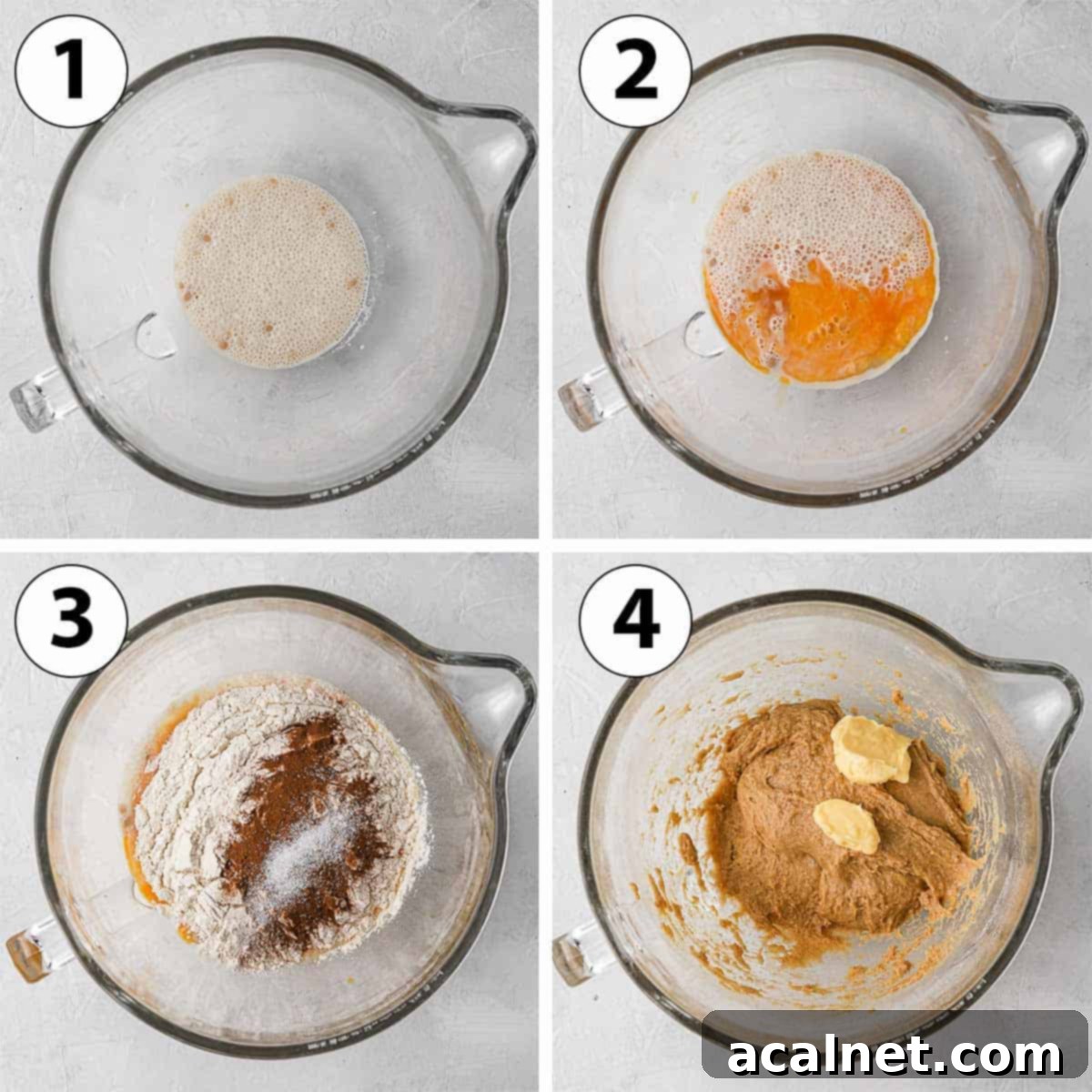
Rolling, Filling, and Shaping Your Babka
Once the babka dough has completed its “bulk fermentation” stage and has beautifully risen, it’s time for the exciting part: preparing the irresistible filling and shaping your babka.
- Photo 5: Preparing the Cinnamon Filling. In a small bowl, combine the soft unsalted butter with the brown sugar and ground cinnamon. Mix these ingredients thoroughly until you achieve a smooth, spreadable paste. If your butter was particularly warm and the filling seems too soft or liquidy, simply place it in the fridge for a few minutes until it firms up to a spreadable consistency. This prevents the filling from oozing out during shaping.
- Photo 6: Rolling the Dough. Gently “punch down” the risen cinnamon babka dough to release the air that has built up during proofing. Transfer the dough onto a lightly floured work surface. Using a rolling pin, carefully roll the dough into a large, even rectangle. Aim for dimensions of approximately 30 x 40 cm (12 x 15 inches). Strive for uniform thickness to ensure even baking.
- Photo 7: Spreading the Filling. With an offset spatula, a silicone spatula, or even the back of a spoon, evenly spread the entire Cinnamon Filling over the rolled-out dough, leaving a small border (about 1 cm or 1/2 inch) around the edges. This helps seal the filling when you roll the dough.
- Photo 8: Rolling into a Log. Carefully and tightly roll the dough from one of its longer sides, creating a neat log shape, much like you would when preparing classic cinnamon rolls. A tight roll is key to achieving those beautiful, distinct swirls in the finished babka.
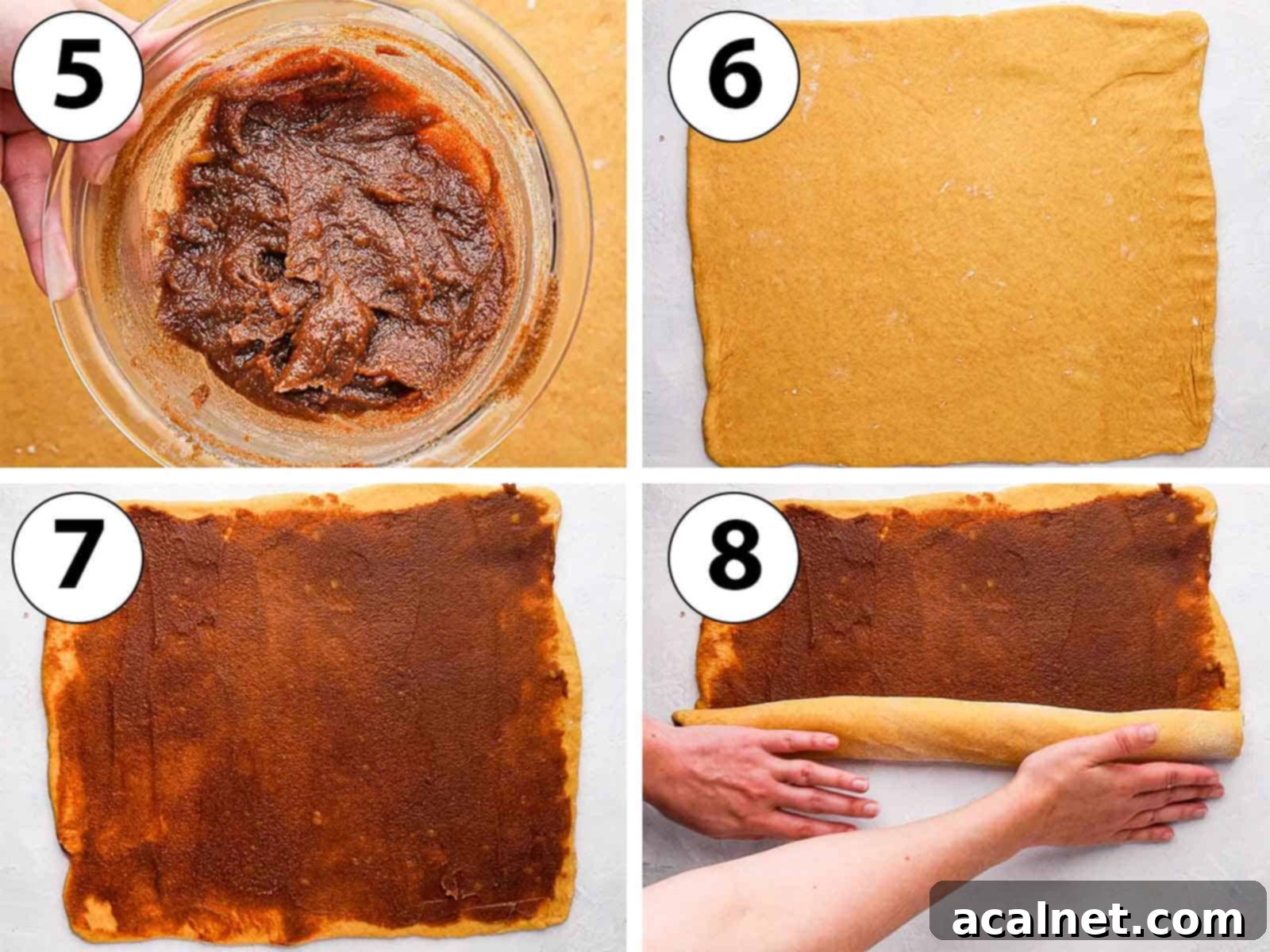
The Art of Shaping, Perfect Baking, and Syrup Glaze
- Photo 9: Slicing the Log. Using a sharp knife or a piece of unflavored dental floss, carefully cut the cinnamon babka dough log in half lengthwise. You will now have two distinct pieces of dough, each revealing the beautiful layers of cinnamon filling spiraling within. This is where the magic of the babka’s iconic twisted look begins!
- Photo 10: Twisting the Babka. Take the two halves of the dough and gently twist them around each other, creating the classic braided, or twisted, babka appearance. Try to keep the cut sides facing upwards as you twist to maximize the visual impact of the cinnamon swirls. For a neater, more professional presentation, you can optionally trim off the two uneven edges of the twisted dough.
- Photo 11: Preparing for Baking. Carefully transfer the twisted babka into a loaf pan that has been thoroughly greased and lined with baking paper, ensuring enough overhang on the sides to easily lift the finished babka out later. A loaf pan measuring approximately 11.5x30cm / 4.5×12 inches works perfectly for this recipe.
- Second Proofing & Egg Wash. Optionally, for an extra golden-brown crust and beautiful shine, brush the top surface of the babka with an egg wash (one egg lightly whisked with a tablespoon of water or milk). Then, cover the loaf pan with a clean tea towel and allow it to proof for a second time in a warm place for about 30 to 45 minutes, or until it has noticeably expanded and risen again.
- Baking to Golden Perfection. While the babka is undergoing its second proof, preheat your oven to 180°C / 350°F. Once the babka has completed its final rise, place it carefully into the preheated oven. Bake for approximately 25 to 30 minutes, or until the babka is gloriously puffed, golden brown on top, and a skewer inserted into the center comes out clean (though be careful not to poke too many holes!).
- Preparing the Sugar Syrup. As your babka nears the end of its baking time (roughly 5-10 minutes remaining), begin preparing the simple Sugar Syrup. Combine the Water and Caster Sugar in a small saucepan and heat it gently on the stove over medium heat. Stir occasionally until the sugar has completely dissolved and the syrup is clear. Remove it from the heat as soon as the sugar dissolves.
- Photo 12: The Finishing Glaze. Immediately upon removing the babka from the oven, while it is still piping hot, generously brush the entire surface with the warm sugar syrup. This step is crucial for adding moisture, a beautiful sheen, and an extra touch of sweetness. Allow the babka to cool down completely in the pan before carefully lifting it out (using the baking paper overhang) and transferring it to a wire rack to finish cooling. This ensures it sets properly and is easier to slice.
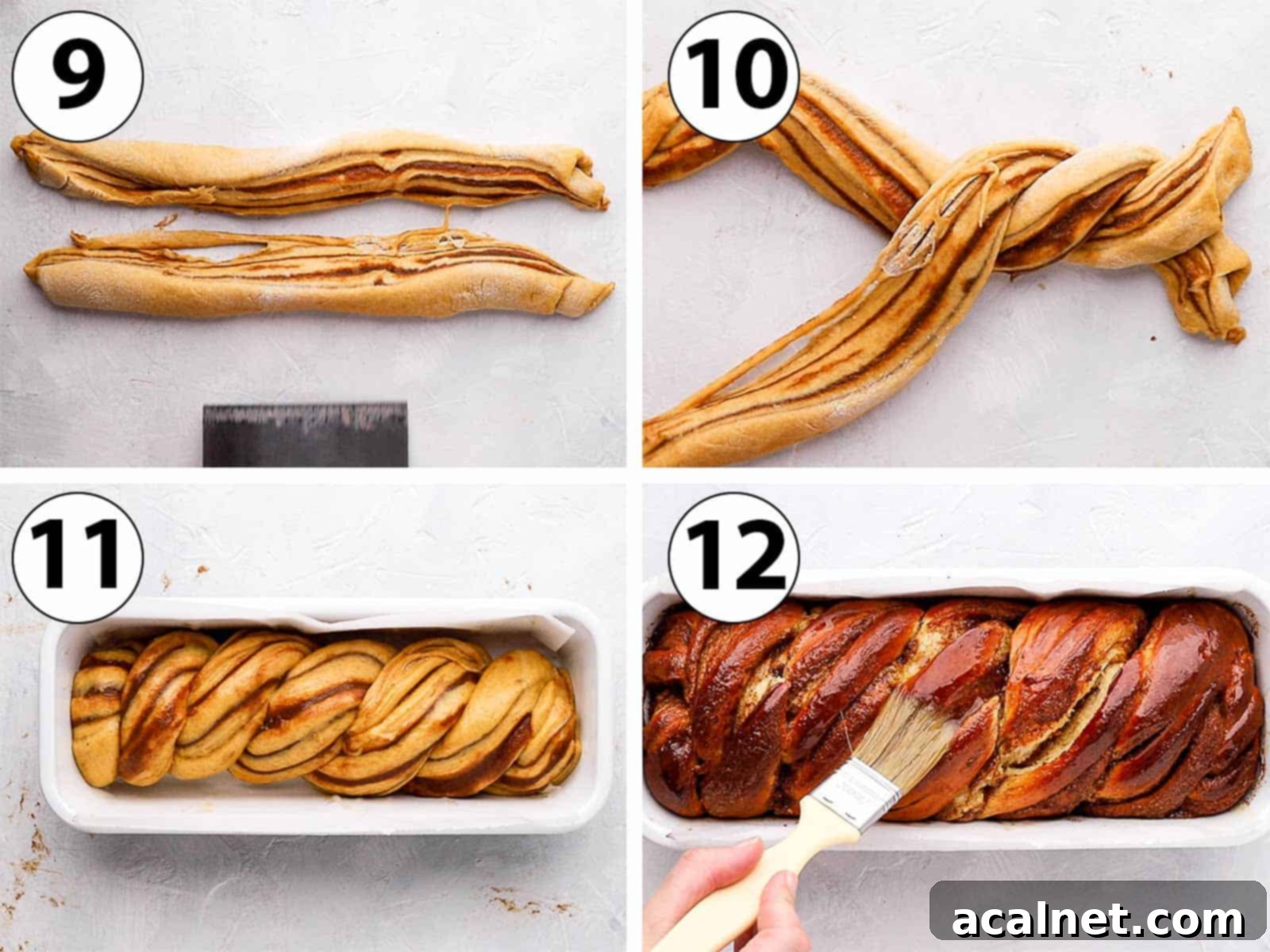
Frequently Asked Questions About Cinnamon Babka
Yes, you can certainly use bread flour in place of plain or all-purpose flour with the same quantities. However, it’s worth noting that classic enriched doughs like brioche, and by extension babka, are typically made with plain/AP flour. This choice of flour helps achieve a lighter, softer, and more tender crumb, which is highly desired for babka. Bread flour, with its higher protein content, tends to develop more gluten, resulting in a slightly chewier texture. So while it will work, the end result might be a little denser than what you’d get with plain flour.
Absolutely! This cinnamon babka recipe provides a fantastic base that is incredibly versatile and can be easily customized with your favorite additions. To enhance the spice profile, consider adding a pinch of other warm spices such as cardamom, a touch of nutmeg, or even a hint of ground ginger. For extra texture and flavor, dried fruits like raisins, cranberries, or chopped apricots can be mixed in. Chopped nuts, such as walnuts or pecans, also make a wonderful addition. And if you’re a chocolate lover, mini chocolate chips or chunks can be folded into the cinnamon filling for a decadent twist!
Yes, indeed! Proofing your babka dough overnight in the refrigerator is actually a fantastic technique that offers several benefits: you will achieve a deeper, more complex flavor in your babka, and the colder proofing allows for a slower rise, contributing to an even softer, more developed texture. Furthermore, a chilled dough is often easier to handle and roll out, making the shaping process smoother. To do this, simply prepare the dough in the evening, cover the bowl securely with plastic wrap to prevent a skin from forming, and place it in the fridge to proof overnight (8-12 hours). In the morning, take the dough out of the fridge and let it come back to room temperature for about 30-60 minutes before proceeding with rolling and adding the filling.
Cinnamon Babka is incredibly versatile and can be enjoyed in many delightful ways! It’s fantastic eaten fresh on its own, when its crumb is at its softest. If it’s a day or two old and has dried out slightly, simply re-heat individual slices in the microwave for a few seconds to restore its tender texture. For an extra decadent treat, toast a slice and spread it with a little butter. Beyond a simple bread, babka can also be served as an impressive dessert. Consider pairing it with a rich cream cheese frosting, a scoop of vanilla ice cream, or a vibrant fruit compote or coulis for an elevated experience. It also makes a wonderful accompaniment to coffee or tea.
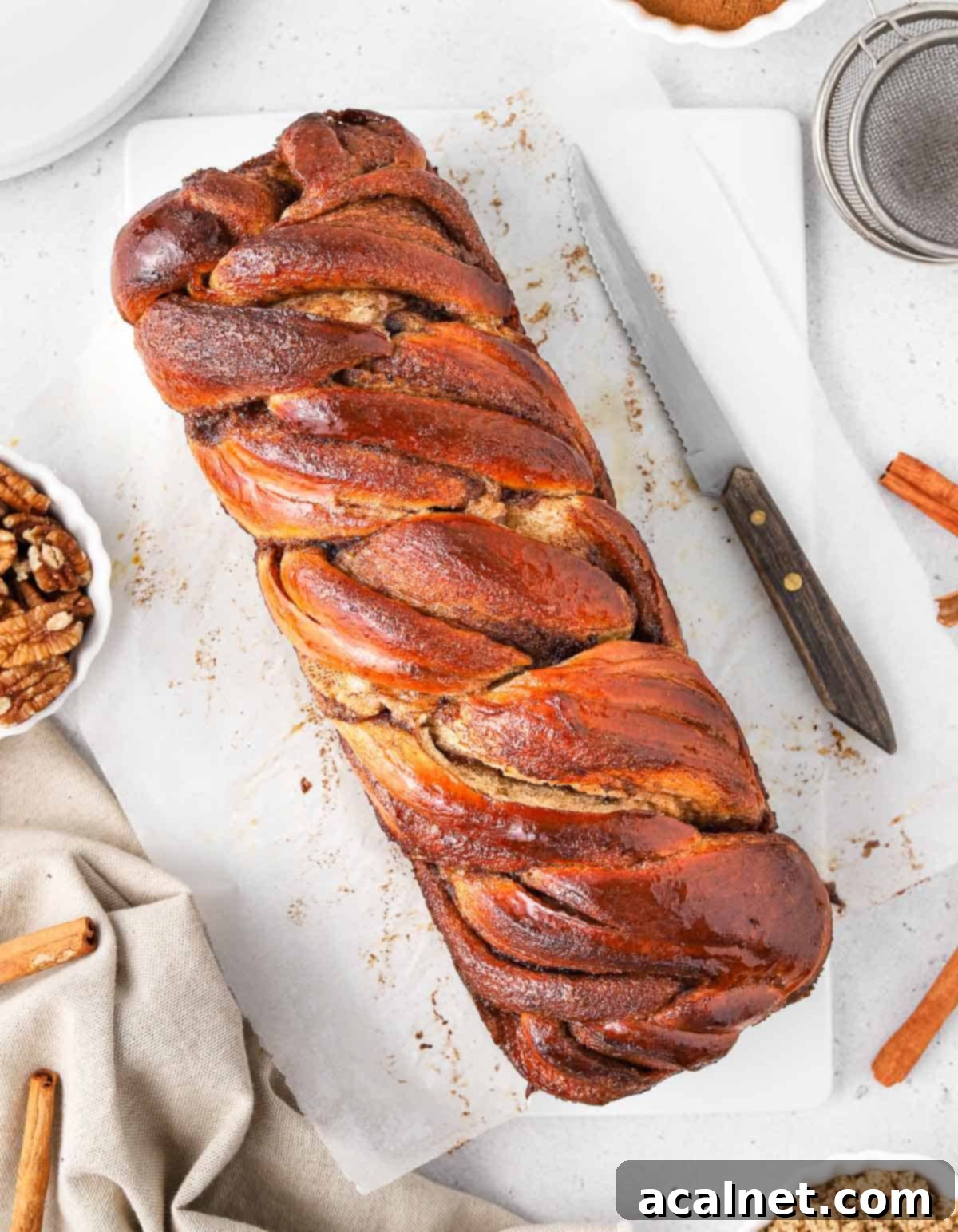
Expert Tips for Baking the Perfect Cinnamon Babka
Achieving a truly spectacular Cinnamon Babka is within reach with a few key techniques and considerations. Follow these expert tips to ensure your baking journey is a resounding success, yielding a babka that’s as beautiful as it is delicious:
- Always Activate Your Yeast: Even when using instant yeast, which technically doesn’t require blooming, I highly recommend this step. Rehydrating the yeast in a small amount of warm liquid (milk in this case) for 5-10 minutes allows you to visually confirm its activity. A bubbly, frothy mixture means your yeast is alive and ready to make your babka rise beautifully. There’s nothing more disappointing than a bread that fails to proof because of inactive yeast, so this simple check is a great insurance policy.
- Master the “Windowpane Test” for Gluten Development: This is a crucial indicator that your dough has been kneaded sufficiently. The windowpane test is a simple yet effective way to check if the gluten has developed enough to create that tender, elastic structure characteristic of babka. To perform it, gently pinch off a small piece of dough and slowly stretch it between your fingers. If the dough tears quickly, it needs more kneading. If it stretches thinly enough to become translucent, allowing light to pass through like a windowpane, then your dough is perfectly kneaded and ready for proofing.
- Embrace Overnight Cold Proofing for Enhanced Flavor and Texture: For a babka with deeper, more complex flavors and an exceptionally tender, lighter texture, consider proofing your dough overnight in the fridge. The slow, cold fermentation not only enriches the taste but also makes the dough much easier to handle, roll, and shape the next day, as the butter solidifies slightly. Simply prepare the dough as instructed, cover the bowl tightly with plastic wrap, and refrigerate for 8-12 hours. The following morning, let it sit at room temperature for 30-60 minutes before proceeding with the filling and shaping.
- Timing is Everything for the Sugar Syrup: Plan to start preparing your Sugar Syrup when your babka has approximately 5-10 minutes left in the oven. The goal is to have both the cinnamon babka and the sugar syrup warm when brushed over. Applying warm syrup to a warm babka allows the syrup to be absorbed more effectively, creating that desirable glossy shine and ensuring the bread remains moist and delicious for longer.
- Unleash Your Creativity with Babka Filling Customizations: While the classic cinnamon filling is divine, don’t hesitate to experiment! You can easily elevate your babka by incorporating various additions to the filling. Consider chopped nuts like walnuts, pecans, or almonds for a delightful crunch. Dried fruits such as raisins, cranberries, or even candied citrus peels add bursts of sweetness and chewiness. For chocolate lovers, a scattering of chocolate chunks, mini chocolate chips, or even a swirl of hazelnut spread (like Nutella) can transform your babka into a truly unique indulgence.
- Achieve a Perfect Twist: When shaping the babka, ensure your dough is rolled into an even rectangle and your filling is spread edge-to-edge (leaving a small border for sealing). When cutting the log lengthwise, use a very sharp knife or even dental floss for a clean cut that reveals the beautiful layers. As you twist the two halves, try to keep the cut sides facing upwards as much as possible to showcase those striking cinnamon spirals once baked.
Storing & Freezing Your Homemade Cinnamon Babka
While this cinnamon babka is undoubtedly best enjoyed fresh on the day it’s baked, when its crumb is at its peak softness and tenderness, you can certainly store it to savor for longer. For optimal freshness, store the babka at room temperature, tightly wrapped in plastic wrap or placed in an airtight container. It will remain delicious for 2-3 days, though its texture might become slightly denser.
If you find your babka has gotten a bit dry after a day or two, individual slices can be easily revived! Simply pop a slice into the microwave for 10-15 seconds, or warm it gently in a toaster oven, to restore its soft, tender crumb and bring back its comforting aroma. This brief warming can make all the difference, making it feel almost freshly baked again.
Babka also freezes exceptionally well, making it a perfect candidate for baking ahead or saving for a future treat! You have two main options for freezing: you can freeze it whole by placing the entire cooled babka on a baking tray in the freezer until it’s completely solid. Once frozen, wrap it tightly in one layer of plastic wrap, followed by a layer of aluminum foil, to protect it from freezer burn. Alternatively, you can pre-cut the babka into individual slices, separating each slice with a piece of baking or parchment paper, and then storing them in an airtight freezer-safe bag or container. When you’re ready to enjoy, simply remove the babka (whole or sliced) from the freezer and leave it to thaw at room temperature for several hours. For whole babkas, you can gently warm them in a low oven (around 150°C/300°F) for 10-15 minutes after thawing for that fresh-baked feel.
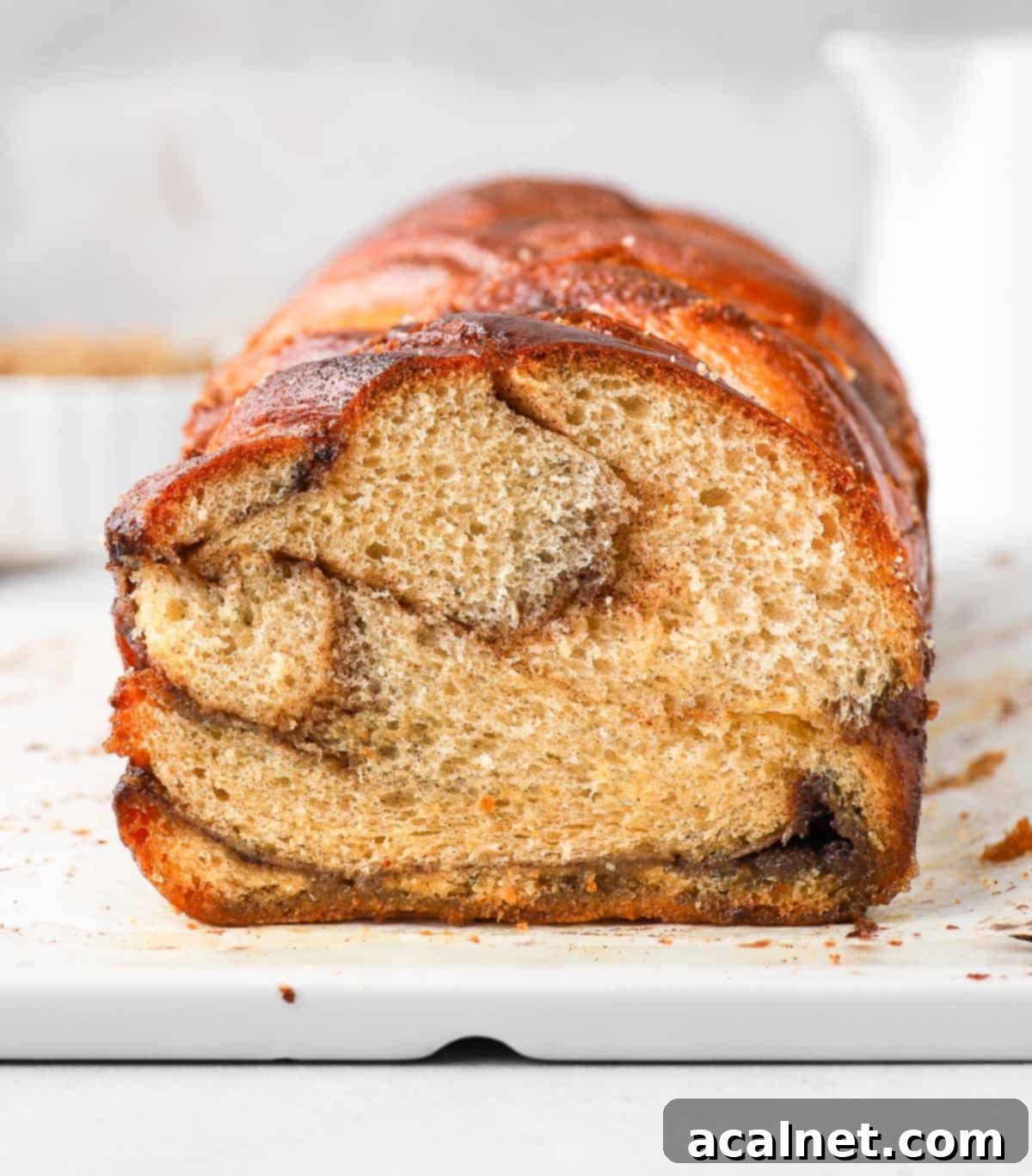
Explore More Delicious Bread Recipes
- Decadent Chocolate Chip Brioche
- Soft & Fluffy Sweet Potato Buns
- Savory Spinach and Ricotta Rolls
- Irresistible Triple Chocolate Cinnamon Rolls
- Warm Apple Cinnamon Pull Apart Bread
- Elegant Chocolate Brioche Wreath
- Rich Chocolate Brioche Bread
- Versatile Challah Rolls (4 Ways)
- Seasonal Pumpkin Buns
Baked this Incredible Babka? We’d Love to Hear From You!
Let us know if you enjoyed this recipe by leaving a comment below and sharing your experience. Don’t forget to tag us on Instagram @a.baking.journey with a photo of your beautiful creation! Happy baking!
Recipe Card: Ultimate Homemade Cinnamon Babka

Cinnamon Babka
Print Recipe
Ingredients
Babka Dough
- 75 ml (5 tablespoons) Full Cream / Whole Milk
- 60 gr (1/4 cup) Caster Sugar
- 9 gr (2 teaspoons) Instant Yeast
- 3 Eggs, at room temperature
- 350 gr (2 1/3 cups) Plain/AP Flour
- 1 teaspoon Ground Cinnamon
- 1/3 teaspoon Fine Salt
- 90 gr (6 tablespoons) Unsalted Butter, soft
Cinnamon Filling
- 120 gr (1/2 cup) Unsalted Butter, soft
- 100 gr (1/2 cup) Brown Sugar
- 2 teaspoon Ground Cinnamon
- 1 Egg, for the Egg Wash (optional)
Syrup Glaze
- 80 gr (1/3 cup) Caster Sugar
- 80 ml (1/3 cup) Water
Instructions
Babka Dough
- Place the lukewarm Milk in the bowl of your stand mixer and mix it with one tablespoon of the Caster Sugar. Add the Yeast, stir then let it bloom for about 10 minutes – or until the mixture looks bubbly / frothy.75 ml (5 tablespoons) Full Cream / Whole Milk, 9 gr (2 teaspoons) Instant Yeast
- Add the Eggs then the Plain/AP Flour, rest of the Caster Sugar, Ground Cinnamon and finish with the salt (see note 1). Knead on medium speed with the dough hook until a sticky dough comes together.60 gr (1/4 cup) Caster Sugar, 3 Eggs, 350 gr (2 1/3 cups) Plain/AP Flour, 1 teaspoon Ground Cinnamon, 1/3 teaspoon Fine Salt
- Add the soft Butter a little bit at the time, kneading until incorporated before adding more (see 2). Keep kneading on medium high to high speed for about 10 minutes, or until the dough passes the “windowpane test”. The babka dough will be very soft and still slightly sticky – that’s normal!90 gr (6 tablespoons) Unsalted Butter
- Cover the bowl with a tea towel and leave it to proof in a warm spot for about 1,5 hours, or until it has doubled in size (see note 3).
Cinnamon Filling
- In a small bowl, mix together the soft butter, cinnamon and brown sugar (see note 4).120 gr (1/2 cup) Unsalted Butter, 100 gr (1/2 cup) Brown Sugar, 2 teaspoon Ground Cinnamon
- Punch the babka dough to remove the air and transfer it over a lightly floured surface. Roll the dough into a large rectangle with a rolling pin, about 30 x 40 cm (12 x 15 inch).
- Spread the Cinnamon Filling over the dough then roll the dough on its longest side to get a log shape. Cut the cinnamon babka dough in half on its length and twist the two pieces of dough around each other.
- Transfer into a loaf pan (11,5x30cm / 4,5×12 inch pan) that has been greased and lined with baking paper. Brush the top of the cinnamon babka with a egg wash then cover with a tea towel and leave to proof in a warm place for 30 to 45 minutes.1 Egg
- Preheat the oven on 180’C/350’F and bake the babka for 25 to 30 minutes or until puffed and golden brown.
Sugar Syrup
- Place the Water and Sugar in a small saucepan and heat up on the stove on medium heat. When the sugar has completely dissolved, remove from the heat.80 gr (1/3 cup) Caster Sugar, 80 ml (1/3 cup) Water
- Take the babka out of the oven and brush it straight away with the hot sugar syrup. Let it cool down completely before removing from the pan.
Video
Would you like to save this recipe?
We’ll email this post to you, so you can come back to it later!
Notes
- Plain/AP Flour: Can be substituted with bread flour if preferred for a slightly chewier texture, but plain/AP flour yields a lighter, softer crumb for babka.
- Yeast: While Instant Yeast is used, if you opt for Active Dry Yeast, remember to properly “bloom” it by re-hydrating it in lukewarm liquid (milk + a pinch of sugar) for 5-10 minutes until frothy, ensuring it’s active before proceeding with the recipe.
Instruction Notes:
- Make sure to add the salt last, after the yeast and flour, to prevent it from directly contacting the yeast, which can inhibit its activity. I find it helpful to mix all dry ingredients (except salt) with a spatula first, then add the salt and gently mix again before using the stand mixer hook.
- The dough will initially be quite greasy and sticky when incorporating the butter. Don’t worry; this is normal for an enriched dough. You may need to stop the mixer periodically and scrape down the sides of the bowl to help the machine fully incorporate the butter. Continue kneading until the dough is smooth and passes the windowpane test.
- Alternatively, for a deeper flavor and easier handling, you can proof the dough overnight in the fridge. Prepare the dough as instructed, cover the bowl tightly with plastic wrap, and refrigerate for 8-12 hours. In the morning, allow the dough to come back to room temperature for 30-60 minutes before rolling and filling.
- If the cinnamon filling appears too soft or liquid (often due to overly warm butter), place it in the fridge for a few minutes. It should firm up to a spreadable consistency, making it much easier to work with when spreading on the dough and preventing it from oozing out during shaping.
Nutrition (per serving)
